Once a month, Mohamed Esimbo Matongu leaves his home in the western Congolese city of Mbandaka and hunts for wild animals. Though he works for a government agency, he says he needs the income from selling most of what he kills to provide for his family. But bushmeat hunters like him are emptying Central Africa’s forests at a high rate, researchers say. When he goes hunting, he rents a dugout canoe and a couple of paddles, and packs a homemade rifle, a dozen cartridges and enough kwanga, a traditional bread made from cassava, to last a few days. He stays in a cabin on a tributary of the Congo river and roams the forest day and night in search of whatever quarry he can find, including monkeys, forest antelopes, crocodiles, pythons and river hogs.
Until the 1990s, hunters like Matongu killed for personal consumption, but growing appetite for wild meat in cities has ramped up the scale of hunting. Research shows around 6 million tonnes of bushmeat are sourced annually from the Congo Basin, whose forest spans across six countries and is second in size only to the Amazon. Many animals, including bonobo apes and pangolins, are protected by international law, but a lack of government oversight means these endangered species are regularly killed.
Matongu says his monthly salary of about $75 is not enough to cover the needs of his wife, four daughters, two brothers and nephew who live under his roof. “How am I supposed to provide for so many people? Sometimes I don’t even get paid at the end of the month”, he said. “This is Congo: we try to do whatever we can to make it”. After a few days hunting in the forest, Matongu sells most of what he killed – making from 5,000 to 100,000 Congolese francs (around $7 to $60) – and keeps just enough meat for his family for a couple of days. His catch goes to Mbandaka’s markets, where thousands congregate every Friday to buy bushmeat from incoming barges. Stands are filled with trussed crocodiles and monitor lizards, as well as freshly killed monkeys, antelopes and other species.
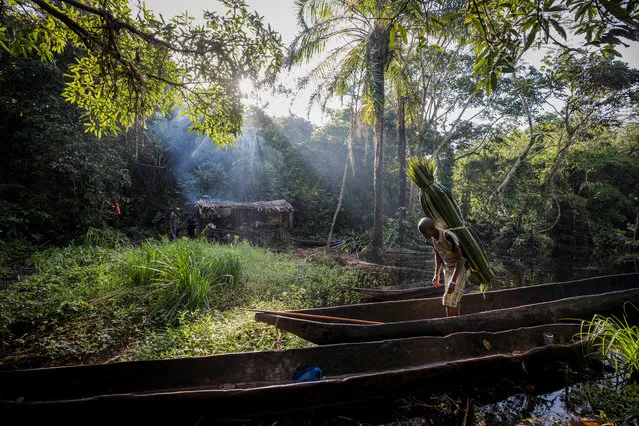
Mohamed Esimbo Matongu carries thatch, which he will use for the roof of his hut, back to his campsite which lies deep in the forest near the city of Mbandaka, Democratic Republic of the Congo, April 3, 2018. (Photo by Thomas Nicolon/Reuters)
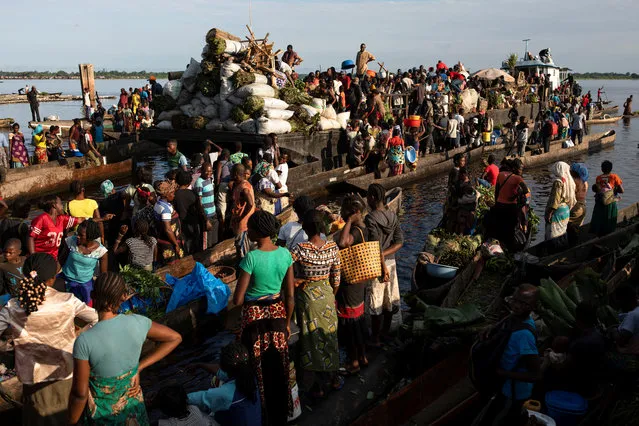
Boats filled with bushmeat arrive at Lingunda market, in Mbandaka, Democratic Republic of the Congo on October 19, 2018. Several hundred men and women wait to buy meat before selling it. (Photo by Thomas Nicolon/Reuters)
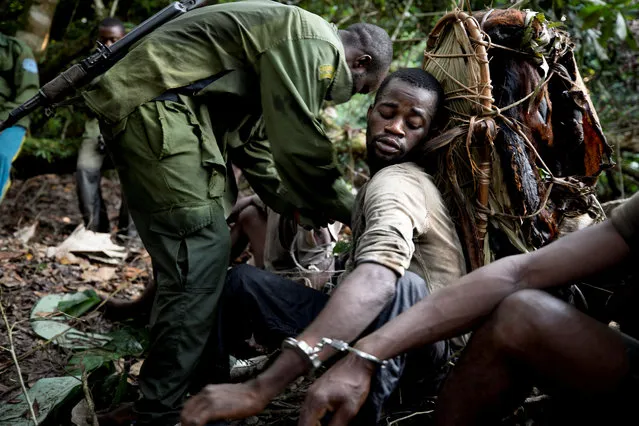
A poacher carrying bushmeat on his back, is detained by park rangers in Salonga National Park, Democratic Republic of the Congo, July 10, 2018. Hunting is prohibited in national parks, which means wildlife is more abundant so poachers often hunt inside the protected areas to find animals with greater ease. (Photo by Thomas Nicolon/Reuters)
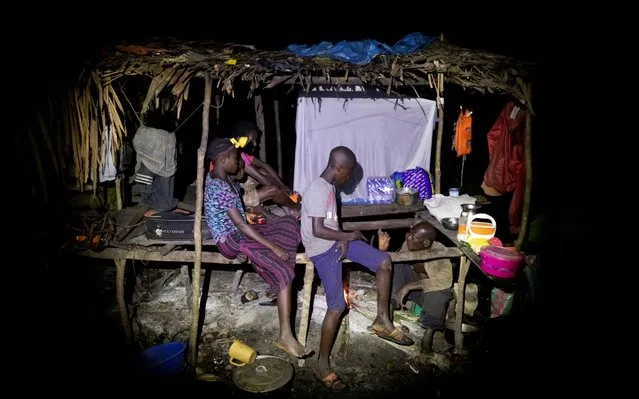
The hunters and their children rest at night after paddling for eight hours to get to their campsite in the forest near Mbandaka, Democratic Republic of the Congo, April 2, 2019. (Photo by Thomas Nicolon/Reuters)
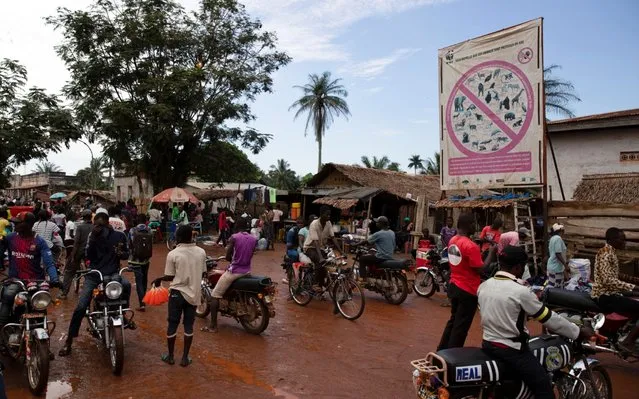
A WWF billboard listing protected species stands in front of a bushmeat market in Mbandaka, Democratic Republic of the Congo, October 19, 2018. (Photo by Thomas Nicolon/Reuters)
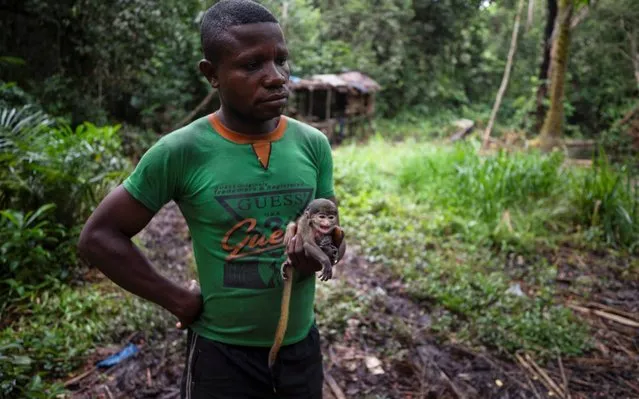
Papy holds a baby red-tailed monkey which a hunter caught after killing its mother, in the forest near the city of Mbandaka, Democratic Republic of the Congo, April 4, 2019. (Photo by Thomas Nicolon/Reuters)
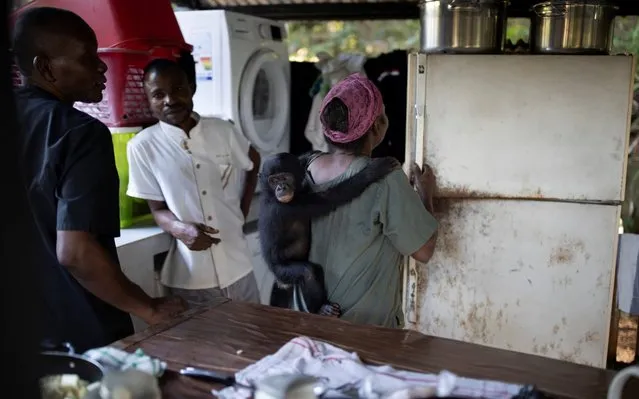
A surrogate mother carries a baby bonobo which was rescued from poachers in Lola ya Bonobo sanctuary in Kinshasa, Democratic Republic of the Congo, November 9, 2018. Many animals, including bonobo apes and pangolins, are protected by international law, but a lack of government oversight means these endangered species are regularly killed. (Photo by Thomas Nicolon/Reuters)
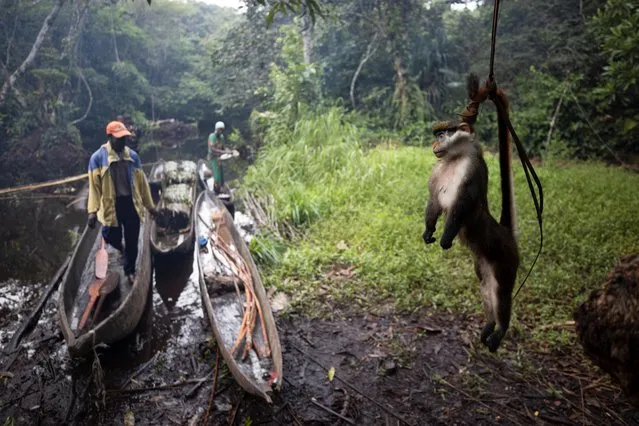
A dead red-tailed monkey hangs by its tail above the ground, in order to keep it away from ants, in the forest near the city of Mbandaka, Democratic Republic of the Congo, April 5, 2019. Bushmeat hunters are emptying Central Africa's forests at a high rate, researchers say. A growing appetite for wild meat in cities has ramped up the scale of hunting. Research shows around 6 million tonnes of bushmeat are sourced annually from the Congo Basin, whose forest spans across six countries and is second in size only to the Amazon. (Photo by Thomas Nicolon/Reuters)
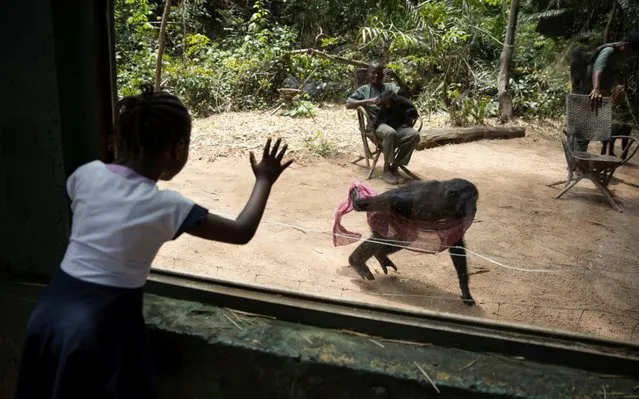
A schoolgirl observes baby bonobos which were rescued from poachers in Lola ya Bonobo sanctuary in Kinshasa, Democratic Republic of the Congo, November 9, 2018. Many animals, including bonobo apes and pangolins, are protected by international law, but a lack of government oversight means these endangered species are regularly killed. (Photo by Thomas Nicolon/Reuters)
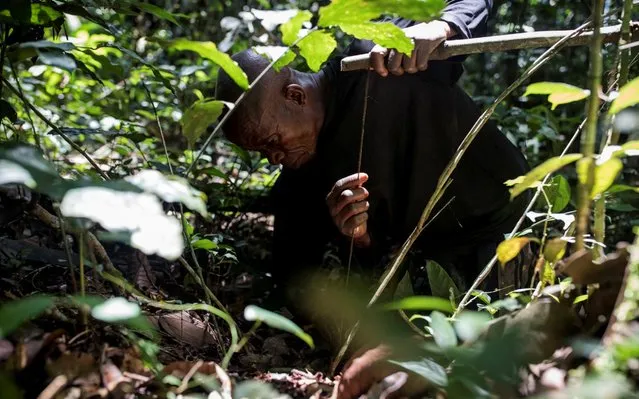
Mohamed Esimbo Matongu checks a trap in the forest near the city of Mbandaka, Democratic Republic of the Congo, April 3, 2018. (Photo by Thomas Nicolon/Reuters)

Three poachers sit on the floor after being detained by park rangers in Salonga National Park, Kinshasa, Democratic Republic of the Congo, July 10, 2018. Hunting is prohibited in national parks, which means wildlife is more abundant so poachers often hunt inside the protected areas to find animals with greater ease. (Photo by Thomas Nicolon/Reuters)
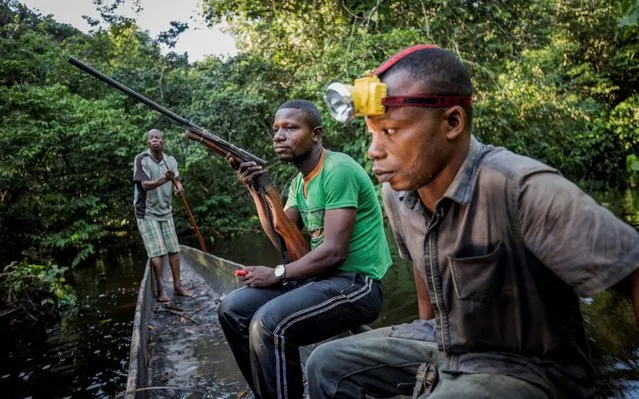
Mohamed Esimbo Matongu, Sadate and Papy return to their campsite empty-handed after a night hunting in the forest near the city of Mbandaka, Democratic Republic of the Congo, April 3, 2018. (Photo by Thomas Nicolon/Reuters)
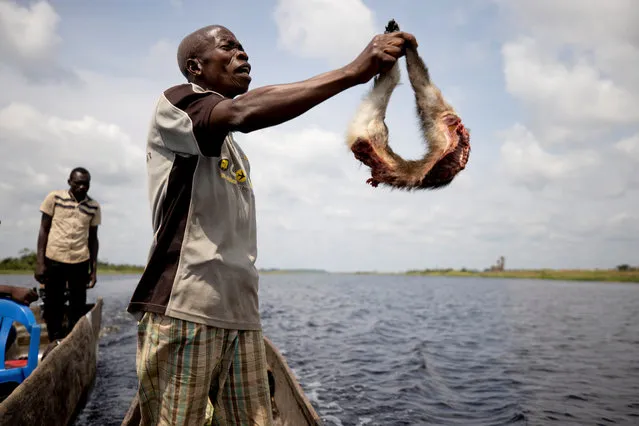
Mohamed Esimbo Matongu offers half a monkey to paddlers on the Ruki river, on his way back to Mbandaka, in the Democratic Republic of the Congo, April 5, 2019. “When I was a teenager, I had to travel no more than 10 km upriver to find animals. But now I have to go as far as 40 km to come across a decent hunting ground”, said Matongu. (Photo by Thomas Nicolon/Reuters)
Until the 1990s, hunters like Matongu killed for personal consumption, but growing appetite for wild meat in cities has ramped up the scale of hunting. Research shows around 6 million tonnes of bushmeat are sourced annually from the Congo Basin, whose forest spans across six countries and is second in size only to the Amazon. Many animals, including bonobo apes and pangolins, are protected by international law, but a lack of government oversight means these endangered species are regularly killed.
Matongu says his monthly salary of about $75 is not enough to cover the needs of his wife, four daughters, two brothers and nephew who live under his roof. “How am I supposed to provide for so many people? Sometimes I don’t even get paid at the end of the month”, he said. “This is Congo: we try to do whatever we can to make it”. After a few days hunting in the forest, Matongu sells most of what he killed – making from 5,000 to 100,000 Congolese francs (around $7 to $60) – and keeps just enough meat for his family for a couple of days. His catch goes to Mbandaka’s markets, where thousands congregate every Friday to buy bushmeat from incoming barges. Stands are filled with trussed crocodiles and monitor lizards, as well as freshly killed monkeys, antelopes and other species.

Mohamed Esimbo Matongu carries thatch, which he will use for the roof of his hut, back to his campsite which lies deep in the forest near the city of Mbandaka, Democratic Republic of the Congo, April 3, 2018. (Photo by Thomas Nicolon/Reuters)

Boats filled with bushmeat arrive at Lingunda market, in Mbandaka, Democratic Republic of the Congo on October 19, 2018. Several hundred men and women wait to buy meat before selling it. (Photo by Thomas Nicolon/Reuters)

A poacher carrying bushmeat on his back, is detained by park rangers in Salonga National Park, Democratic Republic of the Congo, July 10, 2018. Hunting is prohibited in national parks, which means wildlife is more abundant so poachers often hunt inside the protected areas to find animals with greater ease. (Photo by Thomas Nicolon/Reuters)

The hunters and their children rest at night after paddling for eight hours to get to their campsite in the forest near Mbandaka, Democratic Republic of the Congo, April 2, 2019. (Photo by Thomas Nicolon/Reuters)

A WWF billboard listing protected species stands in front of a bushmeat market in Mbandaka, Democratic Republic of the Congo, October 19, 2018. (Photo by Thomas Nicolon/Reuters)

Papy holds a baby red-tailed monkey which a hunter caught after killing its mother, in the forest near the city of Mbandaka, Democratic Republic of the Congo, April 4, 2019. (Photo by Thomas Nicolon/Reuters)

A surrogate mother carries a baby bonobo which was rescued from poachers in Lola ya Bonobo sanctuary in Kinshasa, Democratic Republic of the Congo, November 9, 2018. Many animals, including bonobo apes and pangolins, are protected by international law, but a lack of government oversight means these endangered species are regularly killed. (Photo by Thomas Nicolon/Reuters)

A dead red-tailed monkey hangs by its tail above the ground, in order to keep it away from ants, in the forest near the city of Mbandaka, Democratic Republic of the Congo, April 5, 2019. Bushmeat hunters are emptying Central Africa's forests at a high rate, researchers say. A growing appetite for wild meat in cities has ramped up the scale of hunting. Research shows around 6 million tonnes of bushmeat are sourced annually from the Congo Basin, whose forest spans across six countries and is second in size only to the Amazon. (Photo by Thomas Nicolon/Reuters)

A schoolgirl observes baby bonobos which were rescued from poachers in Lola ya Bonobo sanctuary in Kinshasa, Democratic Republic of the Congo, November 9, 2018. Many animals, including bonobo apes and pangolins, are protected by international law, but a lack of government oversight means these endangered species are regularly killed. (Photo by Thomas Nicolon/Reuters)

Mohamed Esimbo Matongu checks a trap in the forest near the city of Mbandaka, Democratic Republic of the Congo, April 3, 2018. (Photo by Thomas Nicolon/Reuters)

Three poachers sit on the floor after being detained by park rangers in Salonga National Park, Kinshasa, Democratic Republic of the Congo, July 10, 2018. Hunting is prohibited in national parks, which means wildlife is more abundant so poachers often hunt inside the protected areas to find animals with greater ease. (Photo by Thomas Nicolon/Reuters)

Mohamed Esimbo Matongu, Sadate and Papy return to their campsite empty-handed after a night hunting in the forest near the city of Mbandaka, Democratic Republic of the Congo, April 3, 2018. (Photo by Thomas Nicolon/Reuters)

Mohamed Esimbo Matongu offers half a monkey to paddlers on the Ruki river, on his way back to Mbandaka, in the Democratic Republic of the Congo, April 5, 2019. “When I was a teenager, I had to travel no more than 10 km upriver to find animals. But now I have to go as far as 40 km to come across a decent hunting ground”, said Matongu. (Photo by Thomas Nicolon/Reuters)
14 Oct 2019 00:03:00,
post received
0 comments
